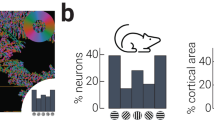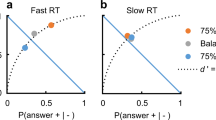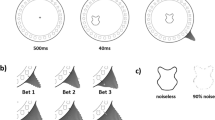Abstract
Perceptual biases are widely regarded as offering a window into the neural computations underlying perception. To understand these biases, previous work has proposed a number of conceptually different, and even seemingly contradictory, explanations, including attraction to a Bayesian prior, repulsion from the prior due to efficient coding and central tendency effects on a bounded range. We present a unifying Bayesian theory of biases in perceptual estimation derived from first principles. We demonstrate theoretically an additive decomposition of perceptual biases into attraction to a prior, repulsion away from regions with high encoding precision and regression away from the boundary. The results reveal a simple and universal rule for predicting the direction of perceptual biases. Our theory accounts for, and yields, new insights regarding biases in the perception of a variety of stimulus attributes, including orientation, color and magnitude. These results provide important constraints on the neural implementations of Bayesian computations.
This is a preview of subscription content, access via your institution
Access options
Access Nature and 54 other Nature Portfolio journals
Get Nature+, our best-value online-access subscription
$29.99 / 30 days
cancel any time
Subscribe to this journal
Receive 12 print issues and online access
$209.00 per year
only $17.42 per issue
Buy this article
- Purchase on Springer Link
- Instant access to full article PDF
Prices may be subject to local taxes which are calculated during checkout







Similar content being viewed by others
Data availability
Code availability
The code, including instructions for using the fitting procedure for the Bayesian modeling developed in the paper, is freely available at https://gitlab.com/m-hahn/unifying-theory-biases.
References
Jastrow, J. Studies from the University of Wisconsin: on the judgment of angles and positions of lines. Am. J. Psychol. 5, 214–248 (1892).
Hollingworth, H. L. The central tendency of judgment. J. Philos. Psych. Sci. Methods 7, 461–469 (1910).
Sadi, R., Asl, H. G., Rostami, M. R., Gholipour, A. & Gholipour, F. Behavioral finance: the explanation of investors’ personality and perceptual biases effects on financial decisions. Int. J. Econ Finance 3, 234–241 (2011).
Frydman, C. & Jin, L. J. Efficient coding and risky choice. Q. J. Econ. 137, 161–213 (2022).
Lieder, I. et al. Perceptual bias reveals slow-updating in autism and fast-forgetting in dyslexia. Nat. Neurosci. 22, 256–264 (2019).
Horga, G. & Abi-Dargham, A. An integrative framework for perceptual disturbances in psychosis. Nat. Rev. Neurosci. 20, 763–778 (2019).
Von Helmholtz, H. Treatise on Physiological Optics, Vol. 3 (Optical Society of America, 1925).
Knill, D. C. & Pouget, A. The Bayesian brain: the role of uncertainty in neural coding and computation. Trends Neurosci. 27, 712–719 (2004).
Körding, K. P. & Wolpert, D. M. Bayesian integration in sensorimotor learning. Nature 427, 244–247 (2004).
Weiss, Y., Simoncelli, E. P. & Adelson, E. H. Motion illusions as optimal percepts. Nat. Neurosci. 5, 598–604 (2002).
Stocker, A. A. & Simoncelli, E. P. Noise characteristics and prior expectations in human visual speed perception. Nat. Neurosci. 9, 578–585 (2006).
Sun, J. & Perona, P. Where is the sun? Nat. Neurosci. 1, 183–184 (1998).
Adams, W. J., Graf, E. W. & Ernst, M. O. Experience can change the ‘light-from-above’ prior. Nat. Neurosci. 7, 1057–1058 (2004).
Huttenlocher, J., Hedges, L. V. & Duncan, S. Categories and particulars: prototype effects in estimating spatial location. Psychol. Rev. 98, 352 (1991).
Jazayeri, M. & Shadlen, M. N. Temporal context calibrates interval timing. Nat. Neurosci. 13, 1020–1026 (2010).
Wei, X.-X. & Stocker, A. A. Efficient coding provides a direct link between prior and likelihood in perceptual Bayesian inference. In Proc. Advances in Neural Information Processing Systems (NIPS 2012) (eds Pereira, F. et al.) 1313–1321 (Curran Associates, 2012).
Wei, X.-X. & Stocker, A. A Bayesian observer model constrained by efficient coding can explain ‘anti-Bayesian’ percepts. Nat. Neurosci. 18, 1509–1517 (2015).
Barlow, H. B. et al. Possible principles underlying the transformation of sensory messages. Sensory Communication (ed. Rosenblith, W. A.) 217–233 (MIT Press, 1961).
Laughlin, S. A simple coding procedure enhances a neuron’s information capacity. Z. Naturforsch. C 36, 910–912 (1981).
Linsker, R. Self-organization in a perceptual network. Computer 21, 105–117 (1988).
Lennie, P. Distortions of perceived orientation. Nat. New Biol. 233, 155–156 (1971).
de Gardelle, V., Kouider, S. & Sackur, J. An oblique illusion modulated by visibility: non-monotonic sensory integration in orientation processing. J. Vision 10, 6 (2010).
Coppola, D. M., Purves, H. R., McCoy, A. N. & Purves, D. The distribution of oriented contours in the real world. Proc. Natl Acad. Sci. USA 95, 4002–4006 (1998).
Girshick, A. R., Landy, M. S. & Simoncelli, E. P. Cardinal rules: visual orientation perception reflects knowledge of environmental statistics. Nat. Neurosci. 14, 926–932 (2011).
Körding, K. P. & Wolpert, D. M. The loss function of sensorimotor learning. Proc. Natl Acad. Sci. USA 101, 9839–9842 (2004).
Bell, A. J. & Sejnowski, T. J. An information-maximization approach to blind separation and blind deconvolution. Neural Comput. 7, 1129–1159 (1995).
Polanía, R., Woodford, M. & Ruff, C. C. Efficient coding of subjective value. Nat. Neurosci. 22, 134–142 (2018).
Wei, X.-X. & Stocker, A. Lawful relation between perceptual bias and discriminability. Proc. Natl Acad. Sci. USA 114, 10244–10249 (2017).
Petzschner, F. H. & Glasauer, S. Iterative Bayesian estimation as an explanation for range and regression effects: a study on human path integration. J. Neurosci. 31, 17220–17229 (2011).
Zhang, H., Ren, X. & Maloney, L. T. The bounded rationality of probability distortion. Proc. Natl Acad. Sci. USA 117, 22024–22034 (2020).
Prat-Carrabin, A. & Woodford, M. Bias and variance of the Bayesian-mean decoder. In Proc. Advances in Neural Information Processing Systems 34 (NeurIPS 2021) (eds Ranzata, M. et al.) 23793–23805 (Curran Associates, 2021).
Stocker, A. A. & Simoncelli, E. Sensory adaptation within a Bayesian framework for perception. Advances in Neural Information Processing Systems 18. In Proc. Advances in Neural Information Processing Systems (NIPS 2005) (eds Weiss, Y. et al.) 1291–1298 (MIT, 2005).
Morais, M. J. & Pillow, J. W. Power-law efficient neural codes provide general link between perceptual bias and discriminability. In Proc. Advances in Neural Information Processing Systems 31 (NuerIPS 2018) (eds Bengio, S. et al.) (Curran Associates, 2018).
Ganguli, D. & Simoncelli, E. P. Implicit encoding of prior probabilities in optimal neural populations. Adv. Neural Inf. Process. Syst. 2010, 658–666 (2010).
Prat-Carrabin, A. & Woodford, M. Efficient coding of numbers explains decision bias and noise. Nat. Hum. Behav. 6, 1142–1152 (2022).
Wei, X.-X. & Stocker, A. Mutual information, Fisher information, and efficient coding. Neural Comput. 28, 305–326 (2016).
Remington, E. D., Parks, T. V. & Jazayeri, M. Late Bayesian inference in mental transformations. Nature Commun. 9, 4419 (2018).
Tomassini, A., Morgan, M. J. & Solomon, J. A. Orientation uncertainty reduces perceived obliquity. Vision Res. 50, 541–547 (2010).
Olkkonen, M., McCarthy, P. & Allred, S. R. The central tendency bias in color perception: effects of internal and external noise. J. Vision 14, 5 (2014).
Bae, G.-Y., Olkkonen, M., Allred, S. R. & Flombaum, J. I. Why some colors appear more memorable than others: a model combining categories and particulars in color working memory. J. Exp. Psychol. Gen. 144, 744–763 (2015).
Xiang, Y., Graeber, T., Enke, B. &Gershman, S. J. Confidence and central tendency in perceptual judgment.Atten. Percept. Psychophys. 83, 3024–3034 (2021).
Gekas, N., Chalk, M., Seitz, A. R. & Seriès, P. Complexity and specificity of experimentally induced expectations in motion perception. J. Vision 14, P355 (2013).
Van Bergen, R. S., Ji Ma, W., Pratte, M. S. & Jehee, J. F. Sensory uncertainty decoded from visual cortex predicts behavior. Nat. Neurosci. 18, 1728–1730 (2015).
Appelle, S. Perception and discrimination as a function of stimulus orientation: the ‘oblique effect’ in man and animals. Psychol. Bull. 78, 266–278 (1972).
Mao, J. & Stocker, A. Holistic inference explains human perception of stimulus orientation. Preprint at bioRxiv https://doi.org/10.1101/2022.06.24.497534 (2022).
Chalk, M., Seitz, A. R. & Seriès, P. Rapidly learned stimulus expectations alter perception of motion. J. Vision 10, 2 (2010).
Gros, B. L., Blake, R. & Hiris, E. Anisotropies in visual motion perception: a fresh look. J. Opt. Soc. Am. A. Opt. Image Sci. Vis. 15, 2003–2011 (1998).
Krukowski, A. E. & Stone, L. S. Expansion of direction space around the cardinal axes revealed by smooth pursuit eye movements. Neuron 45, 315–323 (2005).
Stevens, S. S. & Greenbaum, H. B. Regression effect in psychophysical judgment. Percept. Psychophys. 1, 439–446 (1966).
Huttenlocher, J., Hedges, L. V. & Vevea, J. L. Why do categories affect stimulus judgment?. J. Exp. Psychol. Gen. 129, 220–241 (2000).
Cicchini, G. M., Anobile, G. & Burr, D. C. Compressive mapping of number to space reflects dynamic encoding mechanisms, not static logarithmic transform. Proc. Natl Acad. Sci. USA 111, 7867–7872 (2014).
Mamassian, P. & Goutcher, R. Prior knowledge on the illumination position. Cognition 81, B1–B9 (2001).
Noel, J.-P., Zhang, L.-Q., Stocker, A. A. & Angelaki, D. E. Individuals with autism spectrum disorder have altered visual encoding capacity. PLoS Biol. 19, e3001215 (2021).
Manning, T. S. et al. A general framework for inferring Bayesian ideal observer models from psychophysical data. eNeuro 10, ENEURO.0144-22.2022 (2023).
Tversky, A. & Fox, C. R. Weighing risk and uncertainty. Psychol. Rev. 102, 269 (1995).
Shenoy, P. & Yu, A. J. Strategic impatience in go/nogo versus forced-choice decision-making. In Proc. Advances in Neural Information Processing Systems (NIPS 2012) (eds Pereira, F. et al.) 2132–2140 (Curran Associates, 2012).
Mamassian, P. Overconfidence in an objective anticipatory motor task. Psychol. Sci. 19, 601–606 (2008).
Hudson, T. E., Maloney, L. T. & Landy, M. S. Optimal compensation for temporal uncertainty in movement planning. PLoS Comput. Biol. 4, e1000130 (2008).
Ganguli, D. & Simoncelli, E. P. Efficient sensory encoding and Bayesian inference with heterogeneous neural populations. Neural Comput. 26, 2103–2134 (2014).
Burge, J. & Geisler, W. S. Optimal defocus estimation in individual natural images. Proc. Natl Acad. Sci. USA 108, 16849–16854 (2011).
Park, I. M. & Pillow, J. W. Bayesian efficient coding. Preprint at bioRxiv https://doi.org/10.1101/178418 (2017).
Młynarski, W. F. & Hermundstad, A. M. Efficient and adaptive sensory codes. Nat. Neurosci. 24, 998–1009 (2021).
Roach, N. W., McGraw, P. V., Whitaker, D. J. & Heron, J. Generalization of prior information for rapid Bayesian time estimation. Proc. Natl Acad. Sci. USA 114, 412–417 (2017).
Fritsche, M., Spaak, E. & de Lange, F. P. A Bayesian and efficient observer model explains concurrent attractive and repulsive history biases in visual perception. eLife 9, e55389 (2020).
Gekas, N., McDermott, K. C. & Mamassian, P. Disambiguating serial effects of multiple timescales. J. Vision 19, 24–24 (2019).
Fischer, J. & Whitney, D. Serial dependence in visual perception. Nat. Neurosci. 17, 738–743 (2014).
Ma, W. J., Beck, J. M., Latham, P. E. & Pouget, A. Bayesian inference with probabilistic population codes. Nat. Neurosci. 9, 1432–1438 (2006).
Vilares, I., Howard, J. D., Fernandes, H. L., Gottfried, J. A. & Kording, K. P. Differential representations of prior and likelihood uncertainty in the human brain. Curr. Biol. 22, 1641–1648 (2012).
Funamizu, A., Kuhn, B. & Doya, K. Neural substrate of dynamic Bayesian inference in the cerebral cortex. Nat. Neurosci. 19, 1682–1689 (2016).
Wei, X.-X. & Stocker, A. A. Bayesian inference with efficient neural population codes. In Proc. Artificial Neural Networks and Machine Learning—ICANN 2012: 22nd International Conference on Artificial Neural Networks, Part I 22, (eds Villa, A. E. P. et al.) 523–530 (Springer, 2012).
Fischer, B. J. & Peña, J. L. Owl’s behavior and neural representation predicted by Bayesian inference. Nat. Neurosci. 14, 1061–1066 (2011).
Notredame, C.-E., Pins, D., Denéve, S. & Jardri, R. What visual illusions teach us about schizophrenia. Front. Integr. Neurosci. 8, 63 (2014).
Acknowledgements
This research uses data from a number of previously published studies. We would like to thank G.-Y. Bae, V. de Gardelle, N. Gekas, J. Solomon, R. Polania and C. Ruff for sharing their data with us, as well as the authors of several other studies for making their data publicly available. We thank A. Huttenlocher and M. Woodford for helpful discussions, along with B. Geisler, R. Goris, M. Hayhoe, N. Kriegeskorte, K. Kay, S. Gershman, G. de Hollander and L. Colgin for comments on earlier versions of this paper. X.-X.W. is supported by the startup funds provided by The University of Texas at Austin. M.H. gratefully acknowledges Saarland University for providing computing resources.
Author information
Authors and Affiliations
Contributions
M.H. and X.-X.W. conceived and designed the research. M.H. and X.-X.W. developed the theoretical framework. M.H. performed the theoretical, numerical and data analyses, with input from X.X.W. M.H. and X.-X.W. interpreted the results and wrote the paper.
Corresponding authors
Ethics declarations
Competing interests
The authors declare no competing interests.
Peer review
Peer review information
Nature Neuroscience thanks Pascal Mamassian, John Serences and the other, anonymous, reviewer(s) for their contribution to the peer review of this work.
Additional information
Publisher’s note Springer Nature remains neutral with regard to jurisdictional claims in published maps and institutional affiliations.
Supplementary information
Supplementary Information
Supplementary Information, including additional analyses and mathematical derivations.
Rights and permissions
Springer Nature or its licensor (e.g. a society or other partner) holds exclusive rights to this article under a publishing agreement with the author(s) or other rightsholder(s); author self-archiving of the accepted manuscript version of this article is solely governed by the terms of such publishing agreement and applicable law.
About this article
Cite this article
Hahn, M., Wei, XX. A unifying theory explains seemingly contradictory biases in perceptual estimation. Nat Neurosci 27, 793–804 (2024). https://doi.org/10.1038/s41593-024-01574-x
Received:
Accepted:
Published:
Issue Date:
DOI: https://doi.org/10.1038/s41593-024-01574-x



